Egyptian ballistic missile projects
In the late fifties, the leading countries of the world were actively engaged in rocket-related topics. For example, the USSR and the United States needed missiles capable of delivering nuclear warheads to targets in enemy territory. The Egyptian leadership saw current trends and showed some interest in missiles. The result was the creation of several projects of ballistic missiles with different characteristics. For several years, the Egyptian designers have created a number of interesting projects of rocket technology, which, however, did not have much success. Nevertheless, the Egyptian rocket program is of particular interest from a historical point of view.
Soon after the formation of the United Arab Republic (UAR), which included Egypt and Syria, the leadership of the new country initiated research work in the field of rocket technology. Almost immediately it became clear that the existing scientific and production potential does not allow the country to independently develop ballistic missiles suitable for use in the military. The missile program required technology, knowledge and expertise. All this was only in several countries of the world, first of all in the USSR and the USA. It is known that German specialists played an important role in the creation of the American and Soviet missile programs. Designers from the UAR decided to follow the same path: they found the former German engineers who participated in the projects of Nazi Germany, and invited them to their program.
Al Kaher-1
In 1960, a group of German specialists arrived at the UAR, the purpose of which was to develop new projects, as well as training Egyptian engineers. The development of the first Egyptian ballistic missile project was carried out under the direction of Wolfgang Pilz, Paul Gerke and Wolfgang Kleinwechter. The A-4 project, also known as V-2, was taken as the basis for the development. The Egyptian project received the designation Al Kaher-1.
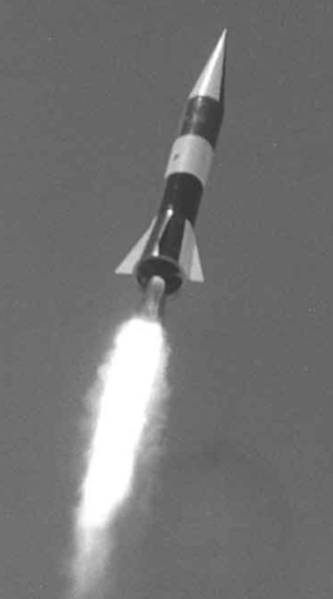 From a technical point of view, the Al Kaher-1 rocket was a smaller copy of the A-4 rocket, with a number of improvements based on the level of development of the Egyptian industry and the latest industry achievements. The product had a length of about 9 meters (according to other data, about 7 m) and a cylindrical body with a diameter of 0,8 m with a tail section extending to 1,2 m. The rocket was equipped with a conical head fairing. Due to the use of German modifications, the first Egyptian rocket received a liquid engine, presumably borrowed from the Wasserfall rocket and modified ethanol-liquid oxygen for the use of the fuel pair.
From a technical point of view, the Al Kaher-1 rocket was a smaller copy of the A-4 rocket, with a number of improvements based on the level of development of the Egyptian industry and the latest industry achievements. The product had a length of about 9 meters (according to other data, about 7 m) and a cylindrical body with a diameter of 0,8 m with a tail section extending to 1,2 m. The rocket was equipped with a conical head fairing. Due to the use of German modifications, the first Egyptian rocket received a liquid engine, presumably borrowed from the Wasserfall rocket and modified ethanol-liquid oxygen for the use of the fuel pair.Rocket Al Kaher-1 had an extremely simple design. The body was proposed to be made from metal sheets and equipped with stamped stabilizers. According to reports, it was decided not to equip the rocket with any control systems. Thus, the product could only be used for strikes against large area targets, for example, at enemy cities. The technical appearance of the Al Kaher-1 rocket suggests that this project had to solve two tasks: to provide armed forces with long-range missile weapons, and also to show the real potential of the industry.
At the beginning of 1962, the German specialists left the project, due to which the Egyptian engineers had to carry out all the remaining work without the help of experienced colleagues. Despite the difficulties encountered, the Al Kaher-1 rocket tests started in the middle of 62. July 21 on one of the Egyptian polygons held two test runs at once. During the tests, several launches were carried out, which made it possible to work out the design of the rocket and test its capabilities.
The new Al Kaher-1 missiles were to become not only a weapon, but also a political tool. For this reason, the first public demonstration of the rocket took place just a couple of days after the test began. 23 July 1962 of the year, on the day of the 10 anniversary of the revolution in Cairo, demonstrated several new missiles. Available materials suggest that weapons were displayed on the parade. In addition, during the 23 parade in July, the rockets were driven by slightly re-equipped trucks, and not by special vehicles.
After the tests and the 62 parade, Egyptian designers refined the existing project, and also completed the development of several tools. In July, 1963, the parade demonstrated rockets with a modified hull design and stabilizers. At the same time, the first show of new self-propelled launchers on automobile chassis took place.
The first Egyptian rocket, Al Kaher-1, is by no means perfect. However, in the early sixties, the UAR urgently needed missile weapons and did not have to choose. According to reports, by the end of 1962, the country's leadership decided to launch Al Kaher-1 into mass production. It was supposed to produce and send to the troops at least 300-400 missiles, the purpose of which were to become Israeli cities and troop concentrations.
Detailed information on the operation and use of Al Kaher-1 missiles is not available. Some sources mention that these missiles were deployed and were intended to attack Israel. However, there is no information on the combat use of missiles against Israeli troops. Al Kaher-1 products were probably not used or were used without noticeable success. A number of Al Kaher-1 missiles remained in storage at the Sinai Peninsula until the start of the Six Day War. All remaining stocks of these weapons, together with launchers and warehouses, were destroyed aviation Of Israel.
Al Kaher-2
In parallel with Al Kaher-1, the Egyptians developed the Al Kaher-2 rocket. The goals of this project were the same, but the 2 rocket had a different look. It had a total length of about 12 m and a cylindrical body with a diameter of 1,2 m without a conical body of the engine compartment. In the tail part of the body there were trapezoidal stabilizers. The rocket was equipped with a fluid engine and did not have any control systems. It is often suggested that the Al Kaher-2 project was created on the basis of German developments and with an eye on the American Viking rocket, in favor of which some features of the Egyptian product can speak. However, UAR engineers did not have access to US projects.
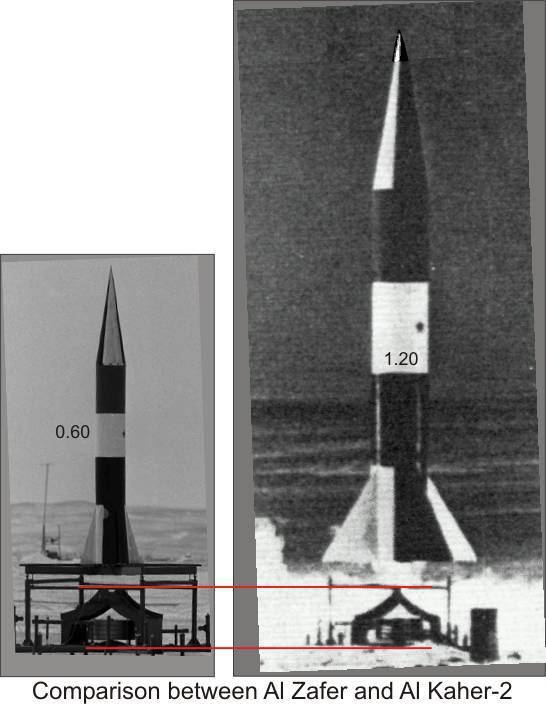
The tests of the Al Kaher-2 rocket launched 21 July 1962 of the year. Two launches marked the beginning of a series of tests, which made it possible to study the capabilities of the rocket and correct the existing shortcomings. However, the Al Kaher-2 project did not progress beyond the testing phase. He allowed the Egyptian engineers to collect the necessary information, but remained purely experimental.
Al Kaher-3
At the 23 parade of July 1962, the Egyptian army showed just two new ballistic missiles: Al Kaher-1 and Al Kaher-3. The rocket with the “3” index can be considered a full-fledged analogue of the German A-4, developed with consideration for the development of industry and technology. Despite some shortcomings and problems, the Al Kahker-3 rocket can be considered the first Egyptian rocket with characteristics that ensured sufficiently high flexibility of use. Thus, the flight distance to 450-500 kilometers allowed attacking targets in Israel without placing launch positions in dangerous proximity to its borders.
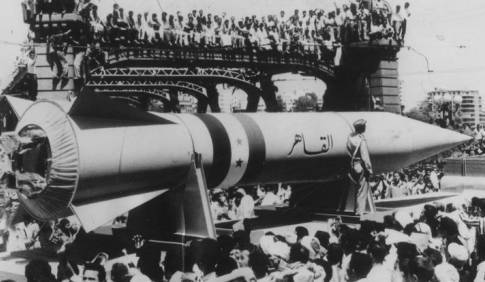
Being an analogue of A-4, the Al Kaher-3 rocket was a bit smaller and lighter. Product length did not exceed 12 m, starting weight - 10 tons. The rocket received a hull with a diameter of 1,4 m with a tail section extending to 1,8 m. As before, the case was equipped with triangular stabilizers. The rocket was again equipped with a fluid engine with a weight of about 17 tons. The characteristics of the new power plant made it possible to bring the launch weight of the rocket to 10 tons and the cast weight to 1 tons.
The tests of the Al Kaher-3 rocket began in the second half of 1962, and showed its relatively high performance. The flight distance to 500 kilometers allowed the Egyptian military to attack Israeli targets in most of the enemy’s territory, depending on the location of the launchers. The ability to use warheads weighing up to 1000 kg increased the real potential of the rocket.
Al Kaher-3 rockets were repeatedly demonstrated at parades marking the anniversary of the revolution. In 1962, the mass production of these products began. It was assumed that Al Kaher-3 will become the main attack tool of the UAR missile forces. However, the economic opportunities of the country did not allow quickly create a reliable rocket shield. As a result, the total number of missiles launched by the new model did not exceed a few hundred. Launchers for missiles Al Kaher-3 located on the Sinai Peninsula. There were built warehouses for the storage of missiles.
Despite ambitious plans, the Al Kaher-3 missiles were never used for their intended purpose. Almost all of the available missiles were destroyed by Israeli aircraft during the Six Day War. At the same time, most of the Egyptian missiles during the bombing were located in warehouses in the unfilled and above-finished form. According to some reports, Israel did not consider the warehouses with Al Kaher-3 missiles as priority targets and did not attempt to destroy them in the first place.
Al Raed
23 July 1963 for the first time in Cairo demonstrated the new Al Raed rocket. Great hopes were pinned on this project: it was alleged that the range of the new missile exceeded several thousand kilometers and allowed strikes against targets in the territory of all opponents of the UAR. However, upon a detailed review of the project, it becomes clear that such statements did not correspond to reality.
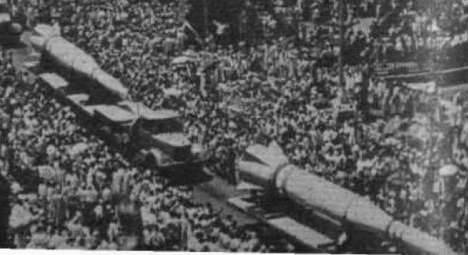
In view of the limited experience in creating rocket technology, the Al Raed product was supposed to be built on the basis of components of the Al Kaher family of rockets. Moreover, Al Raed was a real “hybrid” of Al Kaher-1 and Al Kaher-3 missiles. Such an approach made it possible to provide the army with relatively extended range missiles relatively quickly and easily, but had a lot of specific problems. Nevertheless, it was decided to build a “hybrid rocket” based on the aggregates of the existing products.
The first stage of the Al Raed rocket was the slightly modified Al Kaher-3. A new head fairing with a second-stage fastening system was installed on this rocket. As the second stage, the Al Kaher-1 rocket was used with minimal modifications of the structure, due to the need for installation in the first stage. The Al Raed missile had no control systems.
Information about the tests of the Al Raed missile is not available. This weapon was demonstrated at parades in 1963 and 1964, which indicates approximate project development times. It is noteworthy that the first stages of the missiles, shown in 64, had a slightly larger size in comparison with the first version of the missile aggregates. Probably, such improvements were associated with an increase in the capacity of the fuel tanks to increase the flight range. However, even in this case, the maximum range of the Al Raed missile cannot be estimated more than 1200-1500 km, which is significantly less than the several thousand kilometers announced. Accuracy of firing an unguided rocket at such a range would be extremely low.
Al Raed rockets were shown twice in parades, but apparently did not go into the series. Several factors could have affected the prospects of the project. These are the limited technical and technological capabilities of the UAR / Egypt, the dubious characteristics of the rocket, as well as the country's economic problems that began in the first half of the sixties. Anyway, the Al Raed missiles were not built in series and did not reach the troops.
Import course
For a few years, Egyptian experts, using the help of German engineers, developed four projects of ballistic missiles of different ranges. Products of the Al Kaher family and the Al Raed rocket were repeatedly demonstrated at parades and have a beneficial effect on the patriotic mood of the population. However, they could not have a noticeable impact on the potential of the armed forces and did not manifest themselves in a real war.
Of all the developed missiles, only Al Kaher-1 and Al Kaher-3, produced in quantities of several hundred units, reached mass production. Launchers and warehouses with missiles, for obvious reasons, were located in the Sinai Peninsula, at the minimum possible distance from the Israeli borders. In particular, this affected the fate of the missiles: all of them were destroyed by Israeli forces before the Egyptian military managed to make at least one launch.
Developing their own missiles, Egyptian experts have gained useful experience, but have not been able to use it. Because of the serious lag behind the leading countries, the UAR leadership decided to abandon the further development of their own ballistic missiles and resort to buying foreign technology. Already in the mid-sixties, Cairo began negotiations on the supply of 9K72 Elbrus missile systems with Soviet-made Р-300 missiles.
The P-300 missiles lost to Al Kaher-3 in maximum flight range and drop weight, but they had a lot of advantages over them. So, a self-propelled launcher allowed in the shortest time to take out a rocket to the position and launch, the rocket had greater accuracy, and could also be stored for a long time in the filled form, without requiring a long and complicated preparation procedure for launch. All this ultimately affected the appearance of the Egyptian rocket forces, formed in the late sixties. Attempts to create their own ballistic missiles have ceased.
On the materials of the sites:
http://b14643.de/
http://strangernn.livejournal.com/
http://alternathistory.org.ua/
http://raigap.livejournal.com/
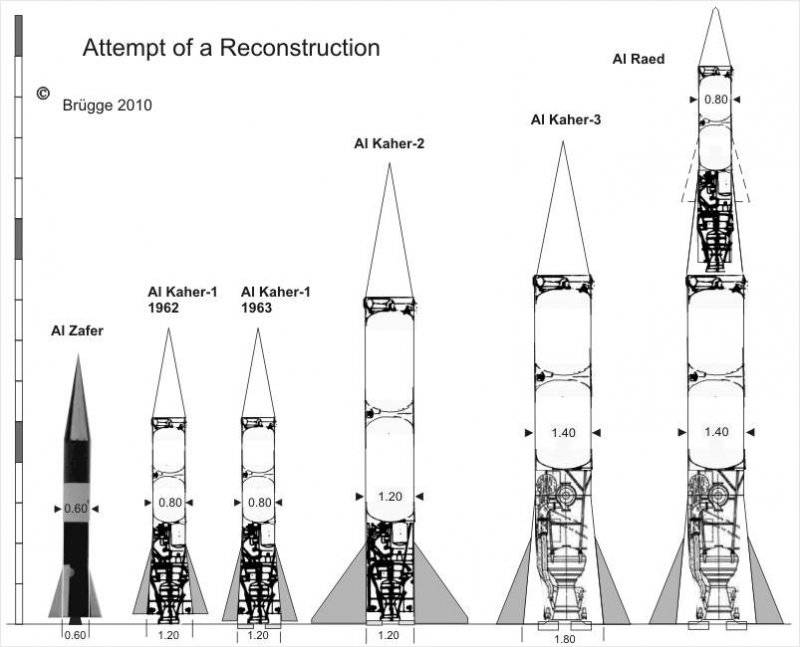
Information